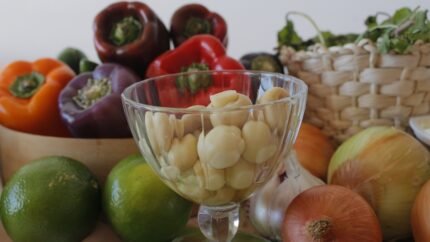Medically reviewed by Dr. Ramesh Gaddam, M.D. — Written by Sumalatha, D.N.H.E
Green Mediterranean Diet
The Green Mediterranean Diet is a variation of the traditional Mediterranean diet that places a stronger emphasis on plant-based foods, particularly green, leafy vegetables. It incorporates the principles of the Mediterranean diet, which is renowned for its potential health benefits, and combines them with an increased focus on plant-derived foods rich in chlorophyll.
Benefits of Green Mediterranean Diet
The Green Mediterranean Diet is a variation of the traditional Mediterranean diet that emphasizes plant-based foods, sustainability, and a reduced environmental impact. Here are some potential benefits associated with adopting a Green Mediterranean Diet:
Heart Health:
- Similar to the traditional Mediterranean diet, the Green Mediterranean Diet is associated with a reduced risk of cardiovascular diseases.
- The emphasis on olive oil, fruits, vegetables, and nuts contributes to heart-healthy fats, fiber, and antioxidants.
Weight Management:
- The diet includes nutrient-dense, fiber-rich foods that can help with weight management.
- Additionally, plant-based diets tend to be lower in calories and saturated fats, promoting a healthy weight.
Improved Digestive Health:
- The high fiber content from fruits, vegetables, whole grains, and legumes supports digestive health by promoting regular bowel movements and a healthy gut microbiota.
Reduced Inflammation:
- The Green Mediterranean Diet is rich in anti-inflammatory foods, such as fruits, vegetables, and olive oil.
- These foods may help to reduce inflammation in the body, which is linked to various chronic diseases.
Better Blood Sugar Control:
- The emphasis on whole grains, legumes, and low-glycemic fruits can contribute to better blood sugar control, which is beneficial for individuals with or at risk of type 2 diabetes.
Cancer Prevention:
- Some components of the Green Mediterranean Diet, such as the antioxidants in fruits and vegetables, have been associated with a lower risk of certain types of cancer.
Environmental Sustainability:
- The focus on sustainability and reduced environmental impact in the Green Mediterranean Diet encourages the consumption of locally sourced, seasonal, and plant-based foods.
- This approach aligns with environmental conservation efforts.
Rich in Antioxidants:
- Fruits, vegetables, nuts, and olive oil are rich in antioxidants, which help protect cells from damage caused by free radicals.
- Antioxidants play a role in preventing chronic diseases and promoting overall health.
Improved Cognitive Function:
- Some studies suggest that the Mediterranean diet, including the Green Mediterranean Diet, may be associated with a lower risk of cognitive decline and neurodegenerative diseases.
Longevity:
- Regions where variations of the Mediterranean diet are commonly followed have been associated with increased longevity.
- The combination of a balanced diet, physical activity, and a healthy lifestyle contributes to overall well-being.
Green Mediterranean Diet Includes:
- Abundance of Vegetables:
- Plant-Based Proteins:
- Whole Grains:
- Healthy Fats:
- Moderate Fish Consumption:
- Limited Red Meat:
- Dairy in Moderation:
- Herbs and Spices:
- Fruits:
- Wine in Moderation:
Abundance of Vegetables: Green, leafy vegetables are central to this diet, providing essential vitamins, minerals, and antioxidants.
Plant-Based Proteins: Sources of plant-based proteins such as legumes, nuts, and seeds play a prominent role.
Whole Grains: Whole grains like quinoa, brown rice, and bulgur are included for fiber and nutrient content.
Healthy Fats: Olive oil, a staple in the Mediterranean diet, continues to be a primary source of healthy fats.
Moderate Fish Consumption: Fish, especially varieties rich in omega-3 fatty acids, is consumed in moderation.
Limited Red Meat: Red meat is limited, with a focus on lean protein sources like poultry.
Dairy in Moderation: Dairy products, particularly those low in fat, are consumed in moderation.
Herbs and Spices: Herbs and spices are used to enhance flavor without relying on excessive salt.
Fruits: A variety of fruits contribute natural sweetness and additional nutrients.
Wine in Moderation: Red wine, consumed in moderation, is a component, reflecting the traditional Mediterranean practice.
Green mediterranean diet food list
Leafy Greens:
Spinach
Kale
Swiss chard
Collard greens
Arugula
Romaine lettuce
Cruciferous Vegetables:
Broccoli
Brussels sprouts
Cauliflower
Cabbage
Herbs and Spices:
Basil
Oregano
Thyme
Rosemary
Cilantro
Mint
Parsley
Fruits:
Berries (blueberries, strawberries, raspberries)
Apples
Oranges
Grapes
Pomegranates
Whole Grains:
Quinoa
Bulgur
Farro
Brown rice
Barley
Whole-grain couscous
Legumes:
Chickpeas
Lentils
Black beans
Cannellini beans
Fava beans
Nuts and Seeds:
Almonds
Walnuts
Pistachios
Chia seeds
Flaxseeds
Sunflower seeds
Healthy Fats:
Extra virgin olive oil
Avocado
Olives
Seafood:
Salmon
Cod
Sardines
Mackerel
Shrimp
Poultry:
Chicken
Turkey
Dairy and Dairy Alternatives:
Greek yogurt
Feta cheese
Goat cheese
Almond milk
Vegetables:
Zucchini
Bell peppers
Tomatoes
Eggplant
Cucumbers
Spreads and Dips:
Hummus
Baba ganoush
Tzatziki
Whole Wheat and Whole Grain Products:
Whole wheat bread
Whole grain pasta
Whole grain crackers
Sweeteners (Use in Moderation):
- Honey
- Maple syrup
Medically reviewed by Dr. Ramesh Gaddam, M.D.

General Physician, Diabetologist, and Critical Care Specialist.
Discover more from Health Build-Up
Subscribe to get the latest posts sent to your email.

2 thoughts on “Green Mediterranean Diet: Benefits, Side Effects, Diet Plans”
Comments are closed.